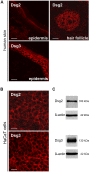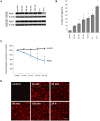Desmoglein 2 is less important than desmoglein 3 for keratinocyte cohesion
- PMID: 23326495
- PMCID: PMC3543261
- DOI: 10.1371/journal.pone.0053739
Desmoglein 2 is less important than desmoglein 3 for keratinocyte cohesion
Abstract
Desmosomes provide intercellular adhesive strength required for integrity of epithelial and some non-epithelial tissues. Within the epidermis, the cadherin-type adhesion molecules desmoglein (Dsg) 1-4 and desmocollin (Dsc) 1-3 build the adhesive core of desmosomes. In keratinocytes, several isoforms of these proteins are co-expressed. However, the contribution of specific isoforms to overall cell cohesion is unclear. Therefore, in this study we investigated the roles of Dsg2 and Dsg3, the latter of which is known to be essential for keratinocyte adhesion based on its autoantibody-induced loss of function in the autoimmune blistering skin disease pemphigus vulgaris (PV). The pathogenic PV antibody AK23, targeting the Dsg3 adhesive domain, led to profound loss of cell cohesion in human keratinocytes as revealed by the dispase-based dissociation assays. In contrast, an antibody against Dsg2 had no effect on cell cohesion although the Dsg2 antibody was demonstrated to interfere with Dsg2 transinteraction by single molecule atomic force microscopy and was effective to reduce cell cohesion in intestinal epithelial Caco-2 cells which express Dsg2 as the only Dsg isoform. To substantiate these findings, siRNA-mediated silencing of Dsg2 or Dsg3 was performed in keratinocytes. In contrast to Dsg3-depleted cells, Dsg2 knockdown reduced cell cohesion only under conditions of increased shear. These experiments indicate that specific desmosomal cadherins contribute differently to keratinocyte cohesion and that Dsg2 compared to Dsg3 is less important in this context.
Conflict of interest statement
Figures





Similar articles
-
Dsg2 Upregulation as a Rescue Mechanism in Pemphigus.Front Immunol. 2020 Oct 28;11:581370. doi: 10.3389/fimmu.2020.581370. eCollection 2020. Front Immunol. 2020. PMID: 33193387 Free PMC article.
-
Desmoglein 2 compensates for desmoglein 3 but does not control cell adhesion via regulation of p38 mitogen-activated protein kinase in keratinocytes.J Biol Chem. 2014 Jun 13;289(24):17043-53. doi: 10.1074/jbc.M113.489336. Epub 2014 Apr 29. J Biol Chem. 2014. PMID: 24782306 Free PMC article.
-
Desmosomal Hyper-Adhesion Affects Direct Inhibition of Desmoglein Interactions in Pemphigus.J Invest Dermatol. 2024 Dec;144(12):2682-2694.e10. doi: 10.1016/j.jid.2024.03.042. Epub 2024 Apr 26. J Invest Dermatol. 2024. PMID: 38677661
-
Desmoglein 3, its pathogenecity and a possibility for therapeutic target in pemphigus vulgaris.Expert Opin Ther Targets. 2013 Mar;17(3):293-306. doi: 10.1517/14728222.2013.744823. Epub 2013 Jan 8. Expert Opin Ther Targets. 2013. PMID: 23294403 Review.
-
Pemphigus: a Comprehensive Review on Pathogenesis, Clinical Presentation and Novel Therapeutic Approaches.Clin Rev Allergy Immunol. 2018 Feb;54(1):1-25. doi: 10.1007/s12016-017-8662-z. Clin Rev Allergy Immunol. 2018. PMID: 29313220 Review.
Cited by
-
Role of ADAM10 and ADAM17 in the Regulation of Keratinocyte Adhesion in Pemphigus Vulgaris.Front Immunol. 2022 Jun 30;13:884248. doi: 10.3389/fimmu.2022.884248. eCollection 2022. Front Immunol. 2022. PMID: 35844545 Free PMC article.
-
Dsg2 Upregulation as a Rescue Mechanism in Pemphigus.Front Immunol. 2020 Oct 28;11:581370. doi: 10.3389/fimmu.2020.581370. eCollection 2020. Front Immunol. 2020. PMID: 33193387 Free PMC article.
-
Identification of altered protein abundances in cholesteatoma matrix via mass spectrometry-based proteomic analysis.J Otolaryngol Head Neck Surg. 2015 Nov 25;44:50. doi: 10.1186/s40463-015-0104-4. J Otolaryngol Head Neck Surg. 2015. PMID: 26608071 Free PMC article.
-
The effect of acellular scaffold loaded with Wharton's jelly-derived stem cells and mineral pitch on healing of burn model in rat.Cell Tissue Bank. 2024 Sep;25(3):785-804. doi: 10.1007/s10561-024-10143-2. Epub 2024 Jun 13. Cell Tissue Bank. 2024. PMID: 38869670
-
Cell cycle- and cancer-associated gene networks activated by Dsg2: evidence of cystatin A deregulation and a potential role in cell-cell adhesion.PLoS One. 2015 Mar 18;10(3):e0120091. doi: 10.1371/journal.pone.0120091. eCollection 2015. PLoS One. 2015. PMID: 25785582 Free PMC article.
References
-
- Getsios S, Huen AC, Green KJ (2004) Working out the strength and flexibility of desmosomes. Nat Rev Mol Cell Biol 5: 271–281. - PubMed
-
- Tsang SM, Brown L, Lin K, Liu L, Piper K, et al. (2012) Non-junctional human desmoglein 3 acts as an upstream regulator of Src in E-cadherin adhesion, a pathway possibly involved in the pathogenesis of pemphigus vulgaris. J Pathol 227: 81–93. - PubMed
-
- Stanley JR, Amagai M (2006) Pemphigus, bullous impetigo, and the staphylococcal scalded-skin syndrome. N Engl J Med 355: 1800–1810. - PubMed
Publication types
MeSH terms
Substances
LinkOut - more resources
Full Text Sources
Other Literature Sources
Miscellaneous

